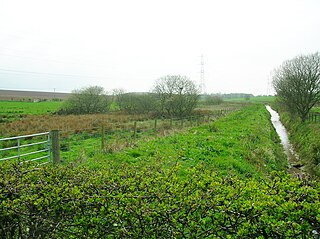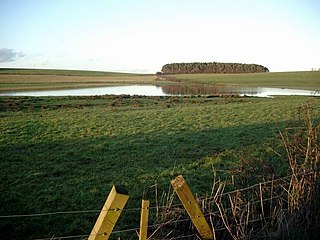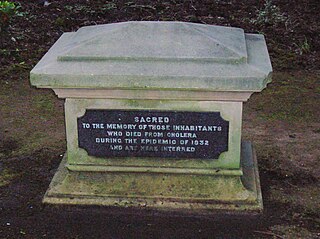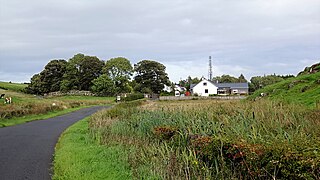
Stewarton is a town in East Ayrshire, Scotland. In comparison to the neighbouring towns of Kilmaurs, Fenwick, Dunlop and Lugton, it is a relatively large town, with a population estimated at over 7,400. It is 300 feet above sea level. The town is served by Stewarton railway station.

Trabboch is a hamlet in East Ayrshire, Scotland. Built as a miners village in the 1880s, it was owned and leased by Wm. Baird & Co., Ltd. and at one time had 94 dwellings. The miners rows stood, until demolition in 1969, on the Stair and Littlemill road, about two miles south of Stair, in that parish. The name is locally pronounced 'Traaboch'.
The village or hamlet of Gatehead is located in East Ayrshire, Parish of Kilmaurs, Scotland. It is one and a quarter miles from Crosshouse and one and a half miles from Kilmarnock. In the 18th and 19th centuries the locality was a busy coal mining district. The settlement runs down to the River Irvine where a ford and later a bridge was located.

Rowallan Castle is an ancient castle located in Scotland. The castle stands on the banks of the Carmel Water, which may at one time have run much closer to the low eminence upon which the original castle stood, justifying the old name Craig of Rowallan. Elizabeth Mure was mistress and then wife of Robert, High Steward of Scotland, and Guardian of Scotland, who later became King Robert II of Scotland. She may have been born at Rowallan.
Riccarton is a village and parish in East Ayrshire, Scotland. It lies across the River Irvine from Kilmarnock, this river forming the boundary between Riccarton and Kilmarnock parishes, and also between the historical districts of Kyle and Cunningham. The name is a corruption of 'Richard's town', traditionally said to refer to Richard Wallace, the uncle of Sir William Wallace. The parish also contains the village of Hurlford.

Kilmaurs Castle was located on the lands of Jocksthorn Farm, near Kilmaurs in East Ayrshire, Scotland. It is described by Timothy Pont in the early 17th century as "Ye castell is ane ancient ftronge building belonging to ye Earls of Glencairne environed with a fair park called Carmell wod from ye vatter of Carmell yat runs by it." Dobie goes on to state that "The old baronial manor place is supposed to have been situated about a mile south-east of Kilmaurs, where some ruins can still be pointed out on the farm of Jakisthorn or Jock's-thorn, probably the original Villam de Cuninghame - the first possession of the family." The castle is not to be confused with the later Cunninghame family possession known as Kilmaurs Place which Dobie calls "..comparatively modern" in 1876.

Busbie Castle was situated in what is now known as Knockentiber, a village in East Ayrshire, Parish of Kilmaurs, Scotland. Knockentiber is 2 miles (3.2 km) WNW of Kilmarnock and 1/2 mile NE of Crosshouse. The castle overlooked the Carmel Glen and its Burn, which runs into the River Irvine, a mile or so to the south, after passing through the old Busbie Mill.

A dead bell or deid bell (Scots), also a 'death', 'mort', 'lych', 'passing bell' or 'skellet bell' was a form of hand bell used in Scotland and northern England in conjunction with deaths and funerals up until the 19th century.

Lochlea or Lochlie was situated in a low-lying area between the farms and dwellings of Lochlea and Lochside in the Parish of Tarbolton, South Ayrshire, Scotland. The loch was natural, sitting in a hollow created by glaciation. The loch waters ultimately drained via Fail Loch, the Mill Burn, and the Water of Fail. It is well-documented due to the presence of a crannog that was excavated and documented circa 1878, and its association with the poet Robert Burns, who lived here for several years whilst his father was the tenant. Lochlea lies 2+1⁄2 miles northeast of Tarbolton, and just over three miles northwest of Mauchline.
Trabboch Castle is a ruined L-plan tower house in the old Barony of Trabboch, Parish of Stair, East Ayrshire, Scotland.

A cholera pit was a burial place used in a time of emergency when the disease was prevalent. Such mass graves were often unmarked and were placed in remote or specially selected locations. Public fears of contagion, lack of space within existing churchyards and restrictions placed on the movements of people from location to location also contributed to their establishment and use. Many of the victims were poor and lacked the funds for memorial stones, however memorials were sometimes added at a later date.

Hiring fairs, also called statute or mop fairs, were regular events in pre-modern Great Britain and Ireland where labourers were hired for fixed terms. They date from the time of Edward III, and his attempt to regulate the labour market by the Statute of Labourers in 1351 at a time of a serious national shortage of labour after the Black Death. Subsequent legislation, in particular the Statute of Apprentices of 1563, legislated for a particular day when the high constables of the shire would proclaim the stipulated rates of pay and conditions of employment for the following year. Because so many people gathered at a fair, it quickly turned into the major place for matching workers and employers. Hiring fairs continued well into the 20th century, up to the Second World War in some places but their function as employment exchanges was diminished by the Corn Production Act 1917. This legislation guaranteed minimum prices for wheat and oats, specified a minimum wage for agricultural workers and established the Agricultural Wages Board, to ensure stability for farmers and a share of this stability for agricultural workers.

The Lands of Tour and Kirkland (NS416406) formed a small estate close to the old Kirktoun and St Maurs-Glencairn collegiate church about 1 km south-east of Kilmaurs, East Ayrshire, Parish of Kilmaurs, Scotland. The word 'Tour' in Scots refers to a 'tower' and 'kirk' to a parish church.

The teenager James Young was murdered on or near Blackhill Road close to Fortacres Farm, Gatehead, Parish of Dundonald in Ayrshire by James McWheelan also recorded as James McQueen on Friday 26 or the early hours of Saturday 27 May 1848. The site is recorded in one report as being "on or near" the Toll Road leading from the Fortacres Farm Toll Bar. The parishes boundaries of Symington, Dundonald and Riccarton, Ayrshire meet in this area.

Kate Kemp of Barskimming lived with her father at the Bridge House on the northern side of the single span Barskimming Old Bridge, River Ayr, Scotland. Both Robert Burns and James Andrew, the miller at Barskimming Mill, had a romantic interest in her and one visit led to the composition of the poem and dirge "Man was made to Mourn".

The ancient Soulis Cross was originally located in the centre of Soulis Street (NS43013821) near the Kilmarnock Water in Kilmarnock, East Ayrshire, Scotland. In 1825 a replacement cross in the form of a fluted pillar topped with an urn was erected using funds raised by public inscription and this was placed near the original site but located in an alcove situated within the high boundary wall of the High Kirk (NS43003820). A brass diamond mark was placed in the road to indicate the original site where Lord Soulis is said to have died, but this is no longer visible as it has become covered with tarmac.

Earlston is a hamlet in Riccarton, East Ayrshire, Scotland. The habitation dates from at least the early 18th century and is near Caprington Castle and Todrigs Mill. It was for many years the site of a large sawmill and a mine pumping engine, and had sidings of the Glasgow and South-Western Railway's Fairlie Branch.

The Bickering bush (NS41863635) thorn grew near Caprington on the lands of Monksholm or Maxholm, Riccarton, East Ayrshire, Scotland. The old farm house at Maxholm sat in hollow on the old Caprington Castle estate and to the north and west its fields bordered the River Irvine. The thorn was located, as recorded on the OS map, near to the confluence of the Kilmarnock Water and the River Irvine, downstream of the Simon's Burn's confluence on the south bank of the river.

Craigie is a small village and parish of 6,579 acres in the old district of Kyle, now South Ayrshire, four miles south of Kilmarnock, Scotland. This is mainly a farming district, lacking in woodland, with a low population density, and only one village. In the 19th century, high quality lime was quarried here with at least three sites in use in 1832.

Kemp Law Dun is a vitrified fort dating from the Iron Age situated near the town of Dundonald in South Ayrshire, Scotland. The remains of the Iron Age fort or dun lie on the old Auchans Estate in the Dundonald Woods near the site of the old Hallyards Farm and the quarry of that name. The footpath route known as the Smugglers' Trail through the Clavin Hills from Troon to Dundonald runs passed the ruins of the dun. Kemps Law is in the order of two thousand years old.


















